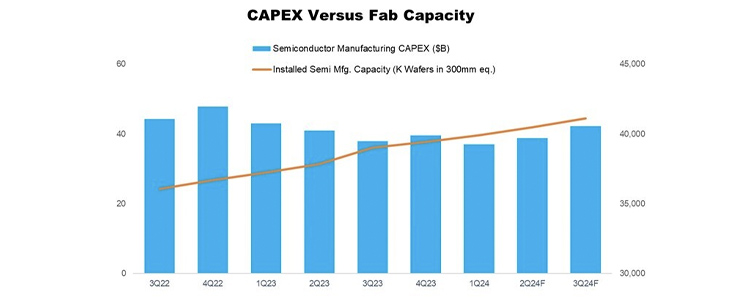
Global semiconductor manufacturing industry strengthens in Q2
SEMI reports that the global semiconductor manufacturing industry continued to show signs of improvement with significant growth of IC sales, stabilizing capital expenditure, and an increase in installed wafer fab capacity in the second quarter of 2024.
While a slower recovery in some end markets impacted the pace of growth in the first half of the year, the surge in demand for AI chips and high bandwidth memory (HBM) created strong tailwinds driving industry expansion.
Seasonality and weaker-than-expected consumer demand impacted electronics sales in the first half of 2024 resulting in a 0.8% decrease YoY. Starting Q3 2024, electronics sales are forecast to see a rebound, growing 4% YoY and 9% relative to Q2 2024. IC sales showed robust 27% YoY growth in Q2 2024 and are further expected to surge 29% in Q3 2024, surpassing record levels seen in 2021 as the AI-fueled demand continues to boost IC sales growth. Improved demand also led to a 2.6% decline YoY in IC inventory levels in the first half of 2024.
Installed wafer fab capacity reached 40.5 million wafers per quarter (in 300mm wafer equivalent) in Q2 2024 and is projected to rise 1.6% in Q3 2024. Foundry and Logic-related capacity showed stronger growth in Q2 2024 at 2.0% and is projected to increase at 1.9% in Q3 2024 driven by capacity build-up for advanced nodes. Memory capacity increased 0.7% in Q2 2024 and is forecast to see 1.1% growth in Q3 2024 supported by strong demand for HBM and improving memory pricing conditions. All regions tracked saw installed capacity increases in Q2 2024 with China remaining the fastest-growing region despite mediocre fab utilisation rates.
Semiconductor capital expenditures remained conservative in the first half of 2024 resulting in a 9.8% decrease YoY. The trend is expected to turn positive starting in Q3 2024 in response to the growing demand for AI chips and rapid adoption of HBM with memory CapEx leading the growth at 16% QoQ while non-memory related capital expenditures increase by 6% QoQ.




